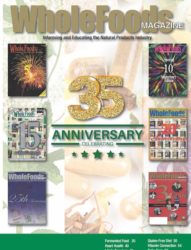What Is Gluten?Gluten is a protein found in wheat, barley and rye that contributes to the elastic texture of dough. However, gluten content is not entirely cut and dry. For instance, oats do not naturally contain gluten, but often are processed alongside other grains and become contaminated with gluten as a result.
Meanwhile, the U.S. Food and Drug Administration (FDA) classifies spelt as wheat, though its molecular makeup and the gluten it contains are quite different from modern wheat (2). Some groups like the World Health Organization say that spelt may be safe for those with certain gluten sensitivities, with a doctor’s approval. Gluten within spelt behaves differently than that of wheat because spelt gluten is more soluble. Again, it is important to talk to your doctor about your options if you feel your body is not digesting gluten products properly.
What Is Celiac Disease?Many individuals associate gluten with celiac disease, a chronic condition caused by an abnormal immune response to gluten (3). If someone with celiac disease ingests gluten, it can damage the lining of the small intestine, which prevents nutrient absorption and can lead to anemia, osteoporosis, weight loss and diarrhea. To test for celiac disease, individuals must receive a blood test that will detect certain antibodies related to an abnormal immune system. A biopsy may then be done to confirm the diagnosis.
Who Else Should Be Gluten Free?Not everyone who needs a gluten-free diet has celiac disease; some are gluten sensitive. This occurs when an individual eats gluten and suffers from similar gastrointestinal distress that plagues celiac disease patients, but the gluten does not cause small intestinal damage. Some individuals with a wheat allergy may also benefit from a gluten-free diet. In these cases, the immune system reacts to one or more wheat proteins, which can include gluten (4). Symptoms may include swelling, itching, hives, diarrhea or trouble breathing.
Other people adopt a gluten-free diet for reasons unrelated to digestive issues. Though there have not been enough large-scale studies to prove its effectiveness, some parents with autistic children believe their behavior, speech and focus improve when they follow a casein- and gluten-free diet. One theory why a gluten-free diet could affect behavior is that many autistic children have trouble breaking down certain peptides and proteins such as gluten. This inability for the body to process these components may exacerbate autistic symptoms (5).
Misconceptions About Gluten-Free DietsGluten-free foods cause weight loss. Some people report less bloating and some weight loss while following a gluten-free diet, but research does not support this unless the manner of going “gluten free” means eating more fresh vegetables and fruit in lieu of refined carbs. Simply adding more gluten-free carbs to the diet, however, may actually increase the amount of calories and fat you consume due to the processing technique required to make some foods gluten free (6).
Gluten free means no gluten. FDA rules say if a product is labeled gluten-free, it must contain less than 20 parts per million (ppm) of gluten. In fact, it is not possible to test whether a product has 0 ppm of gluten; at present, the lowest available testing is 3 ppm of gluten (6). Some groups that certify gluten-free products have higher standards than FDA. Products bearing the Gluten Free Certification Organization (GFCO) seal, for instance, must have 10 ppm or less gluten (7).
Gluten is healthier. In many cases, those who don’t have a gluten allergy, intolerance or sensitivity are not gaining a nutritional advantage with some gluten-free foods. Gluten itself has no nutritional value, but due to the process of removing gluten from wheat products, helpful nutrients such as vitamin B-12, folate, fiber, niacin, vitamin D, zinc, phosphorus and calcium are often lost in the process. Some manufacturers work to replace them, but others leave them out. Therefore, taking an appropriate gluten-free multivitamin may be necessary (8).
Gluten is only found in bread-based products. Many everyday foods have gluten hidden in them. Some of those products include soy sauce, teriyaki, ketchup, mayonnaise, salad dressings, lunch meat and soup, depending on the recipe. It is also possible for naturally gluten-free items to become cross-contaminated with gluten (9). For this reason, those with celiac disease or a gluten sensitivity are best off buying gluten-free items with a trusted gluten-free certified seal.
In the end, it is important to read all labels carefully if a gluten-free diet is important for you. Talk to a physician, nutritionist or dietitian to help you fully understand what a gluten-free diet entails.WF
Published in WholeFoods Magazine July 2016
References
- International Food Information Council, “What’s Your Health Worth?” www.foodinsight.org/sites/default/files/2015-Food-and-Health-Survey-Full-Report.pdf, accessed May 18, 2016.
- Nature’s Legacy, “What Is Spelt?” https://natureslegacyforlife.com/faqs/what-is-spelt, accessed Mar. 31, 2016.
- WebMD, “Celiac Disease: Topic Overview” www.webmd.com/digestive-disorders/celiac-disease/celiac-disease-topic-overview, accessed Mar. 31, 2016.
- “Celiac vs Gluten-Sensitivity vs Wheat Allergies,” http://gastro.ucla.edu/site.cfm?id=281, accessed Mar. 31, 2016.
- WebMD, “Gluten-Free/Casein-Free Diets for Autism,” www.webmd.com/brain/autism/gluten-free-casein-free-diets-for-autism#2, accessed Mar. 31, 2016.
- Gluten Intolerance Group, “The Gluten-Free Diet: Facts and Myths,” www.gluten.org/resources/getting-started/the-gluten-free-diet-facts-and-myths, accessed Mar. 31, 2016.
- J. Anderson, “Why You Should Know Products’ Gluten PPM Numbers,” Dec. 15, 2014, http://celiacdisease.about.com/od/PreventingCrossContamination/a/Why-Parts-Per-Million-Matters.htm, accessed Mar. 31, 2016.
- C. Kupper, “The Gluten-Free Nutrition Guide,” www.gluten.org/wp-content/uploads/2015/01/EDU_GFNtrtnGd_8-16-11.pdf, accessed May 18, 2016.
- Celiac Disease Foundation, “Sources of Gluten,” https://celiac.org/live-gluten-free/glutenfreediet/sources-of-gluten, accessed Mar. 31, 2016.










